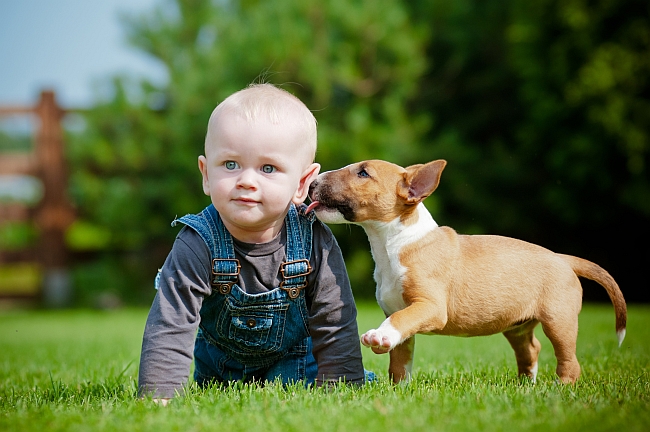
When working with children, it is always ideal to have a “yes” environment; one that opens up opportunities instead of shutting down their imagination and fun with limits and rules. However, sometimes teaching a child to have a healthy respect of an animal, and the consequences of pestering or roughly playing with them is the best thing you can do. Since even well-intended dogs can resort to knee-jerk reactions and instincts, it is best to teach children what to do and what not to do when they are around both strange dogs, and familiar pets.
Tips on Keeping Your Child From Getting Bitten
TEACH children to recognize a safe dog. When a dog is wagging his tail, panting and appears happy, this is a safe dog to approach or reach out your hand to.
TEACH children to recognize the dogs that they should avoid. These traits will include: either a closed mouth (indicating a tense dog) barring teeth, growling, (indicating aggression), raised fur, and pointed tail. Practice pointing out certain dogs to your children and ask them if they are safe to play with in that moment or not, based all on their posture and body language.
TEACH children better/safer games to play with the dog, such as fetch with a ball or stick. This will put them in not only the “dominant figure” position, but will exercise the dog well, and keep his teeth and rambunctious energy directed somewhere else.
DON’T let the child approach any strange dog (even ones on a leash) without a parent.
DON’T ever take a toy away from a dog, or try to pull a sock, ball, stick or treat out of his mouth.
DON’T distract, pet or interrupt as dog while he is trying to eat. (This actually has proven the cause of many biting attacks on children, especially for the Bulldog breed.)
DON’T let children come up to the dog’s face, stare squarely into his eyes or hold his head with their hands.
AVOID the dog if he is sleeping, curled up on his bed, or clearly wants to be left alone.
DON’T ever try to reach a dog or pet it through a fence. (This could make little fingers look like tasty morsels.)
ALWAYS wash hands before playing with a dog. In case the child has sticky hands from snack time, or helping mommy make dinner, a dog may try to lick or chomp on the hand.
DON’T ever climb into a crate with a dog, even if he seems friendly, or is a familiar dog to you. Being trapped or contained in a small space might make the dog more aggressive than usual. Open-space play time is always a better option.
NEVER attempt to stop the dog from chasing the kitty, or try to stop two dogs from playing or wrestling. Sometimes children watch this and then want to join in the fun, or break up a “fight,” and then go on to suffer for it.

